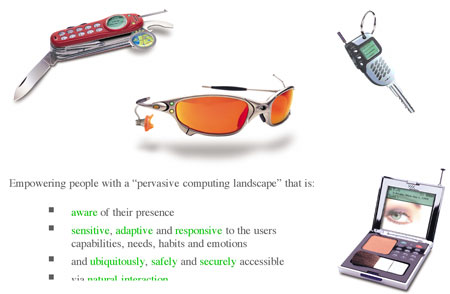1 & 2: The idea of being 'usable-in-life' is that, although something may seem impressive in an abstract situation, i.e. usable-in-itself, the technology should be tested within the context of its everyday use.
3: According to the article, the iPod is designed to be as simple to use as possible, yet responsive in all situations. The paper cites the example of being able to increase the volume of the music whilst the user is jogging as evidence for usability-in-life. 'Excellent mappings' and 'consistency' are cited as reasons for the usability-in-itself of the iPod,
Wednesday, 15 October 2008
Thursday, 9 October 2008
Studio 2 | iPod Usability Explorations
Re-write of Schneiderman's '8 Golden Rules of Interface Design'
The following evaluation method will test three of Shneiderman's Eight Golden Rules of Interface Design:
The first heuristic ('offer informative feedback') should be covered by the first instruction (information about the song playing) and the further two heuristics should be satisfied by the user's ability to navigate to the new song. The "allow 'undo'" heuristic is satisfied by the task directly, since the task emulates that the user has chosen an erroneous song to play.
- Strive for consistency
- Always make sure that the same actions produce the same (or similar) results. For example, rotating the iPod's wheelpad clockwise will always scroll menus down/right and counterclockwise will always scroll menus up/left.
- Enable frequent users to use shortcuts
- The iPod allows for the user to customise which items appear on the main menu screen to provide quicker access to common tasks.
- Offer informative feedback
- This means the system does something in response to the user's action which gives him/her information about what s/he has done. For example, rotating the wheelpad on the iPod results in a volume scale going up and down telling you you have changed the volume. And you can hear it too.
- Design dialogs to yield closure
- The user should easily be able to tell when a task has been completed. For example, when selecting a menu item with the iPod Video, the screen animates the old menu scrolling off the screen and the new menu shifting in from the right.
- Allow 'undo'
- The system should allow for any input to be reversed. For example, if you select an unwanted song to play on the iPod, you can simply press the 'menu' button and return to the list of songs again.
The following evaluation method will test three of Shneiderman's Eight Golden Rules of Interface Design:
- Offer informative feedback
- Allow 'undo'
- Reduce short-term memory load
The first heuristic ('offer informative feedback') should be covered by the first instruction (information about the song playing) and the further two heuristics should be satisfied by the user's ability to navigate to the new song. The "allow 'undo'" heuristic is satisfied by the task directly, since the task emulates that the user has chosen an erroneous song to play.
Tuesday, 7 October 2008
Studio 1 | Definitions and Images of Pervasive Computing
Definitions
Pervasive Computing



The definitions of pervasive and ubiquitous computing all appear to be referring to the same concept, that devices will interact with each other and become so integrated into the environment that users shouldn't notice they are there.
However, Ambient Computing (Intelligence) seems to take the idea that the devices should sense and respond to humans automatically without actual user intervention.
Pervasive Computing

- http://searchnetworking.techtarget.com/sDefinition/0,,sid7_gci759337,00.html:
- Pervasive computing is the trend towards increasingly ubiquitous (another name for the movement is ubiquitous computing), connected computing devices in the environment, a trend being brought about by a convergence of advanced electronic - and particularly, wireless - technologies and the Internet. Pervasive computing devices are not personal computers as we tend to think of them, but very tiny - even invisible - devices, either mobile or embedded in almost any type of object imaginable, including cars, tools, appliances, clothing and various consumer goods - all communicating through increasingly interconnected networks. According to Dan Russell, director of the User Sciences and Experience Group at IBM's Almaden Research Center, by 2010 computing will have become so naturalized within the environment that people will not even realize that they are using computers. Russell and other researchers expect that in the future smart devices all around us will maintain current information about their locations, the contexts in which they are being used, and relevant data about the users.
- http://www.webopedia.com/TERM/P/pervasive_computing.html:
- The idea that technology is moving beyond the personal computer to everyday devices with embedded technology and connectivity as computing devices become progressively smaller and more powerful. Also called ubiquitous computing, pervasive computing is the result of computer technology advancing at exponential speeds -- a trend toward all man-made and some natural products having hardware and software. Pervasive computing goes beyond the realm of personal computers: it is the idea that almost any device, from clothing to tools to appliances to cars to homes to the human body to your coffee mug, can be imbedded with chips to connect the device to an infinite network of other devices. The goal of pervasive computing, which combines current network technologies with wireless computing, voice recognition, Internet capability and artificial intelligence, is to create an environment where the connectivity of devices is embedded in such a way that the connectivity is unobtrusive and always available.
- http://www.pcmag.com/encyclopedia_term/0,2542,t=pervasive+computing&i=49146,00.asp:
- Refers to the use of computers in everyday life, including PDAs, smartphones and other mobile devices. It also refers to computers contained in commonplace objects such as cars and appliances and implies that people are unaware of their presence. One of the Holy Grails of this environment is that all these devices communicate with each other over wireless networks without any interaction required by the user.

- http://en.wikipedia.org/wiki/Ubiquitous_computing:
- Refers to the use of computers in everyday life, including PDAs, smartphones and other mobile devices. It also refers to computers contained in commonplace objects such as cars and appliances and implies that people are unaware of their presence. One of the Holy Grails of this environment is that all these devices communicate with each other over wireless networks without any interaction required by the user.
- http://www.cc.gatech.edu/classes/cs6751_97_fall/projects/say-cheese/marcia/mfinal.html:
- Ubiquitous computing, or calm technology, is a paradigm shift where technology becomes virtually invisible in our lives. Instead of having a desk-top or lap-top machine, the technology we use will be embedded in our environment. From the ubiquitous computing page at Xerox PARC [UBPARC] we have the following description: imagine a world with hundreds of wireless computing devices of different sizes in the same room. In order to bring this type of computing out into the environment, among the things we need to rethink are user interfaces, displays, operating systems, networks, and wireless communications.
- http://vdict.com/ubiquitous computing,6,0,0.html:
- Computers everywhere. Making many computers available throughout the physical environment, while making them effectively invisible to the user. Ubiquitous computing is held by some to be the Third Wave of computing. The First Wave was many people per computer, the Second Wave was one person per computer. The Third Wave will be many computers per person. Three key technical issues are: power consumption, user interface, and wireless connectivity. The idea of ubiquitous computing as invisible computation was first articulated by Mark Weiser in 1988 at the Computer Science Lab at Xerox PARC.

- http://en.wikipedia.org/wiki/Ambient_intelligence:
- In computing, ambient intelligence (AmI) refers to electronic environments that are sensitive and responsive to the presence of people. Ambient intelligence is a vision on the future of consumer electronics, telecommunications and computing that was originally developed in the late 1990s for the time frame 2010–2020. In an ambient intelligence world, devices work in concert to support people in carrying out their everyday life activities, tasks and rituals in easy, natural way using information and intelligence that is hidden in the network connecting these devices (see Internet of Things). As these devices grow smaller, more connected and more integrated into our environment, the technology disappears into our surroundings until only the user interface remains perceivable by users.
- http://www.ami-07.org/:
- Ambient Intelligence represents a vision of the future where we shall be surrounded by electronic environments, sensitive and responsive to people. Ambient Intelligence technologies are expected to combine concepts of ubiquitous computing and intelligent systems putting humans in the centre of technological developments.
The definitions of pervasive and ubiquitous computing all appear to be referring to the same concept, that devices will interact with each other and become so integrated into the environment that users shouldn't notice they are there.
However, Ambient Computing (Intelligence) seems to take the idea that the devices should sense and respond to humans automatically without actual user intervention.
Subscribe to:
Posts (Atom)
